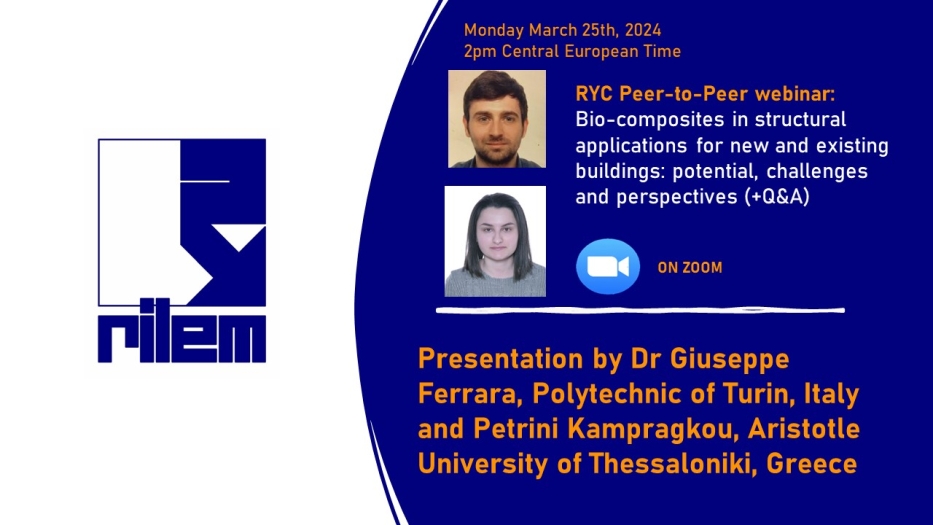Events calendar
Region : Europe

Peer-to-Peer Webinar: Bio-composites in structural applications for new and existing buildings: potential, challenges and perspectives
The next Peer-to-Peer webinar will take place on Monday March 25th, 2024 at 2pm Central European Time and will be one hour long (2*20 minutes presentations + 15-minute interaction). The registration for this webinar is free.
Theme of the Peer-to-Peer Webinar: Bio-composites in structural applications for new and existing buildings: potential, challenges and perspectives
REGISTER FOR FREE HERE.
Speaker 1: Dr Giuseppe Ferrara, Polytechnic of Turin, Italy
Title: Natural Textile Reinforced Mortar composites
In recent years the use of bio-composites has significantly increased, and the related global market is estimated to rise more than threefold during the next decade. This trend responds to the urgent need of sustainable solutions across several industrial sectors, such as automotive, construction, packaging, and consumer goods.
Composites including plant fibres as reinforcement in either organic or inorganic matrices is emerging as innovative construction material with possible applications in existing and new buildings. However, several issues are still open concerning the use of plant fibres in inorganic matrices (Natural Textile Reinforced Mortar composite systems, NTRM), and the studies in the literature addressing this aspect, although showing a great potential of these systems, are not enough to widely promote their application. A dedicated work group was created as part of the RILEM technical committee 290-IMC to investigate the properties of several NTRM produced with different types of plant fibres, confirming the increasing attention of the scientific community toward this category of materials.
With the aim of raising the awareness in the use of NTRMs main promising results in terms of mechanical behaviour, and related challenges, are outlined. Experimental results concerning the characterisation of different types of textiles, their durability, and the tensile behaviour of the composite itself are shown. Moreover, potential and limitations of the natural composite to reinforce structural element are disclosed by highlighting main results of experimental campaigns carried out on masonry elements externally strengthened by NTRM systems. Finally, the latest research advancements with respect to fibres pre-treatment are described and shown as possible strategy aimed at improving the overall mechanical behaviour of the composite system.
Speaker 2: Petrini Kampragkou, Aristotle University of Thessaloniki, Greece
Title: Bio-reinforced cement mortars
Τhe practice of using bio-fibres as mortars’ reinforcements dates back to ancient times. Natural fibres such as straw, wood and animal hair were incorporated in traditional mortars to improve their volume stability and enhance their strength. After a period of modernization and replacement of the renewable and biodegradable bio-fibres with steel, plastic and glass ones, the re-emergence of these bio-solutions in the construction industry intents on reducing the environmental degradation and the overconsumption of the mineral resources.
However, the chemical composition and the hygroscopic nature of the natural fibres have thus far restricted their wide application in mortar enhancement. More specifically, the fibres’ high-water absorbency increases the water demand of mortar mixtures leading to poor adhesion between fibres and binder and furthermore to declination of the mortars’ strength. Additionally, the exposure of bio-fibres to alkaline environmental conditions, such as the cement matrix, seems to enhance their degradation. Therefore, suitable natural fibre treatments for permanently modifying their chemical composition and hydrophilic character have constantly been sought.
The exposure of black pine and beech fibres (two widely used local wood species) to mild hydrothermal treatment (140 °C, 2 h, under a steam atmosphere) seems to slightly decrease the extracts, hemicelluloses and hydroxyl groups of the natural material, improving their utilization potential as raw materials in mortars. Moreover, the incorporation of these treated wood fibres in cement mortars mixtures (with 1.5% v/v addition rate, after many trials in the lab) revealed their beneficial role in the dimensional stability, flexural strength, thermal insulation properties and capillary absorption of the mortar specimens. The improvement of these properties was also recorded long-term during the ageing process, with the black pine fibres to show the greatest performance. So, the mild hydrothermally treated wood fibres seem to perform satisfactory in cement matrix through ageing providing low-cost, green and sustainable mortar reinforcement pathways.
This webinar is brought to you by the RILEM Youth Council (RYC) and hosted by Niki Trochoutsou (Europe RYC representative) in collaboration with Magda Posani (Europe RYC representative).
No comment
Log in to post comment. Log in.





